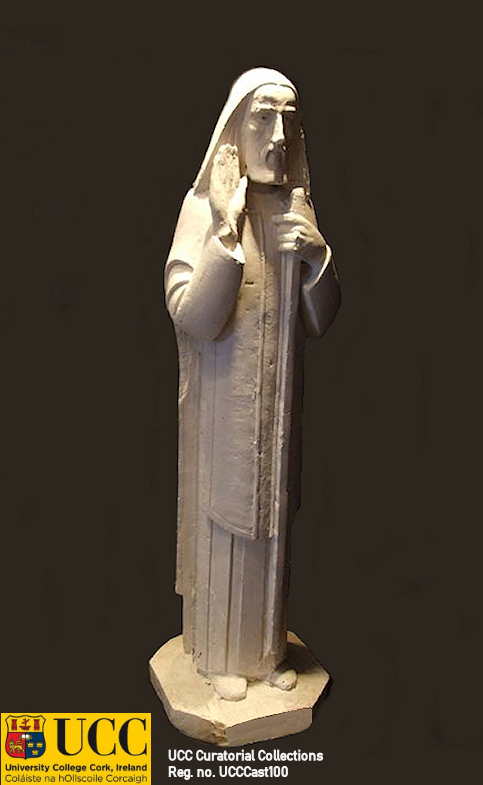Maquette, Séamus Murphy RHA, 'St Finbarr'

Plaster: 'St Finbarr', 1933, maquette, H c.90 cm, W 24 (max)
Ref: UCCHS.UCCCast100 © University College Cork
Sculptor: Séamus Murphy RHA (1907-1975), Irish.
Murray, Catalogue No 29 (p103, with photo, p50): "St Finbarr. 1933, limestone, 213 cm h. Note: Plaster version in Visitor Centre, UCC."
Date: 1933
Provenance: Commissioned by the Academy of St Thomas, UCC, in 1933. Gifted to the Governing Body, University College, Cork, in 1934.
Context
In 1934 the statue of Queen Victoria was removed from its position on the roof above the Aula Maxima and replaced by one of St Finbarr. The removal of a queen and her replacement by a saint took place in the context of the strongly nationalist and Catholic religious atmosphere of the 1930s. The renowned Cork sculptor, Séamus Murphy, then newly returned to Ireland from his studies in Paris, was given the commission. The work was paid for by funds raised by a college society, the Academy of St Thomas, founded by the then Registrar (later President) of UCC, Alfred O’Rahilly. The new statue was presented to the Governing Body by the Academy in June 1934 (Murphy, 234; Cork Examiner, 19/6/1934). As noted in the Cork Examiner (5/6/1934, 7), this was 'the first religious statue to be accepted by any of the three constituent Colleges of the National University of Ireland'.
St Finbarr was chosen as he was regarded as the traditional founder of an early Christian monastery known to have existed in Gillabbey, a site close to the College. The sense of the College having an affinity and continuity with this monastery was important in Cork in the nineteenth century when Queen’s College, Cork, was founded in 1845, and since. Modern research by Pádraig Ó Riain, Emeritus Professor of Old Irish, UCC, has cast doubt on the reality behind the Finbarr connection with that monastery but somehow the story still survives. Thus a relic of Ireland’s former colonial status was replaced by a mythical figure.
The statue of St Finbarr, that is now on the apex of the gable of the Aula Maxima, is carved in Irish limestone and stands at 2.13 metres high and weighs 1½ tons (about 1,500 kg). Facing east, he is depicted as a cowled monk, bearded, holding a crozier as a symbol of his authority and with his right glove-encased hand raised in blessing – tradition had it that the Saviour appeared to the kneeling Finbarr, whom he raised up by the saint’s right hand (Cork Examiner, 5/6/1934, 7).
Artist
Séamus Murphy was born on 15 July 1907 at Greenhill, Burnfort, near Mallow, Co. Cork, but moved with his family to Cork city when he was very young. He received his early education in Cork. He then became an apprentice stone-carver at John A. O’Connell’s Art Marble Works, Watercourse Road, Blackpool, where he specialised in architectural and foliage carving. He was also attending the Crawford School of Art in Cork city centre at this time. In 1931 he was awarded the Gibson Bequest Scholarship and exhibited at the Royal Hibernian Academy exhibition. In 1932-33, he studied in Paris at the Académie Colarossi and at the Académie de la Grande Chaumière. He returned home in 1934 and opened his studio at the Watercourse Road. Murphy was elected associate of the Royal Hibernian Academy in 1944 and a decade later became a full member. In 1964 he was appointed RHA Professor of Sculpture and became a member of the Arts Council of Ireland in 1973. The National University of Ireland conferred him with an honorary LLD in 1969.
His exhibitions included: Salon de Printemps, Société des Artistes, 1933; a group exhibition at UCC in 1935; World Fair, New York, 1939; solo exhibition in Cork Public Library, 1956; joint exhibition with artist William Harrington, 1967; Adare, Co. Limerick, 1973; exhibited at ROSC ’75, Cork; as well as at the Royal Hibernian Academy. A retrospective exhibition was held in 1982 at the Crawford Municipal Gallery of Art, Cork, and at the Douglas Hyde Gallery, TCD. His memoir Stone Mad, first published in 1950, remains in print, and in 2013 was chosen as Cork’s Favourite Book.
Séamus Murphy married Maighread Higgins (daughter of sculptor Joseph Higgins (1885-1925) and Katherine Turnbull), with whom he had two daughters and one son. He died in Cork on 2 October 1975 and is buried in Rathcooney cemetery, north of Cork city.
The RTÉ website has several online films that feature Séamus Murphy:
‘Sculpting in Cork’ (1965)
‘Stone Mad’ (1969)
‘Working with stone’ (1973)
See also: ‘A home for sculpture in Cork’ (1967)
Sources
'Cork sculptor’s work. Interesting gift to U.C.C. Statue of St. Finbarr' (with photo), Cork Examiner, 5 June 1934, 7
'University College, Cork', Cork Examiner, 19 June 1934, 10
Peter Murray (ed.), "Séamus Murphy (1907–1975) Sculptor" (Kinsale: Produced by Gandon Editions for the Crawford Art Gallery, 2007), no. 29 (p.103) and photo p.70
Francis Hyland and Bebhinn Marten, Séamus Murphy 1907–1975: The work of Séamus Murphy Sculptor (Dublin: Douglas Hyde Gallery, c.1982), p.23, cat. no. 4. [exhibition catalogue with essays]
Minch, Rebecca, ‘Murphy, Séamus’, Dictionary of Irish Biography
John A. Murphy, The College: a history of Queen’s / University College, Cork (Cork: Cork University Press, 1995)
Pádraig Ó Riain, The making of a saint: Finbarr of Cork 600-1200, Subsidiary series 5 (London: Irish Texts Society, 1997)
Séamus Murphy RHA: https://seamusmurphysculptor.com/wp/
© University College Cork 2021
